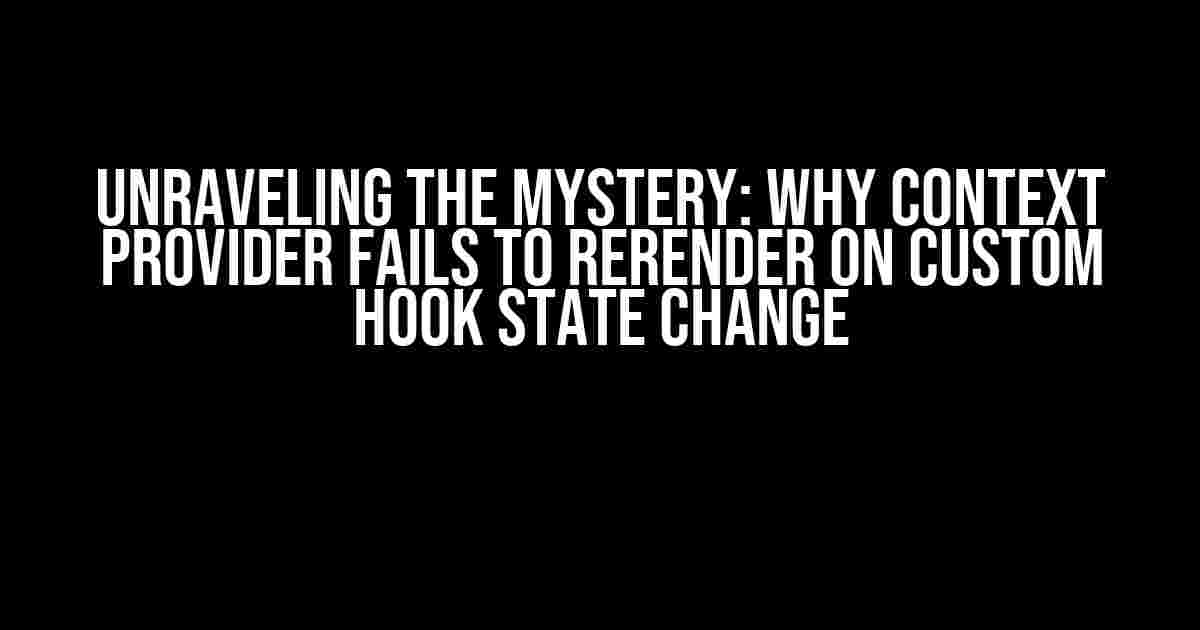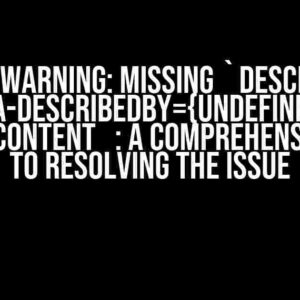Have you ever stumbled upon an issue where your Context Provider refuses to rerender when the state changes in your custom hook? You’re not alone! This frustrating problem has puzzled many developers, and today, we’re going to dive deep into the world of React Context and custom hooks to uncover the root cause and provide a solution.
Understanding the Basics
Before we dive into the meat of the issue, let’s quickly review the basics of React Context and custom hooks.
React Context
React Context is a powerful tool that allows you to share data between components without having to pass props down manually. It’s a centralized store that holds the state and makes it accessible to any component that needs it.
import { createContext, useState } from 'react';
const ThemeContext = createContext();
const ThemeProvider = ({ children }) => {
const [theme, setTheme] = useState('light');
return (
{children}
);
};
Custom Hooks
Custom hooks are reusable functions that allow you to encapsulate complex logic and share it across components. They’re essentially a way to “hook into” React state and lifecycle methods from functional components.
import { useState, useEffect } from 'react';
const useFetchData = (url) => {
const [data, setData] = useState(null);
const [loading, setLoading] = useState(false);
useEffect(() => {
setLoading(true);
fetch(url)
.then((response) => response.json())
.then((data) => setData(data))
.finally(() => setLoading(false));
}, [url]);
return { data, loading };
};
The Problem: Context Provider Fails to Rerender
Now that we’ve covered the basics, let’s move on to the issue at hand. Imagine you have a custom hook that fetches data from an API and updates the state in your Context Provider. However, when the state changes, the Context Provider fails to rerender, leaving your components stuck with the old data.
import { createContext, useState, useContext } from 'react';
import useFetchData from './useFetchData';
const DataContext = createContext();
const DataProvider = ({ children }) => {
const { data, loading } = useFetchData('https://api.example.com/data');
return (
{children}
);
};
In this example, when the `useFetchData` hook fetches new data, the `DataContext` Provider doesn’t rerender, even though the state has changed.
Why Context Provider Fails to Rerender
The reason behind this issue lies in how React Context and custom hooks work together. When you use a custom hook within a Context Provider, the hook’s state is not automatically linked to the Context Provider’s state.
In other words, when the custom hook’s state changes, it doesn’t trigger a rerender of the Context Provider. This is because the Context Provider only rerenders when its own state changes, not when the state of a nested hook changes.
The Solution: Force Rerendering the Context Provider
So, how do we force the Context Provider to rerender when the custom hook’s state changes? The solution is surprisingly simple: we can use the `useState` hook to create a new state that’s tied to the custom hook’s state, and then use that state to trigger a rerender of the Context Provider.
import { createContext, useState, useContext } from 'react';
import useFetchData from './useFetchData';
const DataContext = createContext();
const DataProvider = ({ children }) => {
const { data, loading } = useFetchData('https://api.example.com/data');
const [providerState, setProviderState] = useState({ data, loading });
if (data !== providerState.data || loading !== providerState.loading) {
setProviderState({ data, loading });
}
return (
{children}
);
};
In this updated example, we create a new state called `providerState` that’s initialized with the custom hook’s state. We then use a conditional statement to check if the custom hook’s state has changed, and if so, we update the `providerState` using the `setProviderState` function. This triggers a rerender of the Context Provider, ensuring that the new state is propagated to all connected components.
Optimizing Performance with Memoization
One potential issue with the solution above is that it can lead to unnecessary rerenders of the Context Provider. To optimize performance, we can use memoization to cache the state and only update it when necessary.
import { createContext, useState, useContext, useMemo } from 'react';
import useFetchData from './useFetchData';
const DataContext = createContext();
const DataProvider = ({ children }) => {
const { data, loading } = useFetchData('https://api.example.com/data');
const [providerState, setProviderState] = useState({ data, loading });
const memoizedState = useMemo(() => ({ data, loading }), [data, loading]);
if (!isEqual(providerState, memoizedState)) {
setProviderState(memoizedState);
}
return (
{children}
);
};
const isEqual = (a, b) => {
return JSON.stringify(a) === JSON.stringify(b);
};
In this example, we use the `useMemo` hook to create a memoized state that’s only updated when the custom hook’s state changes. We then use a custom `isEqual` function to compare the memoized state with the provider’s state, and only update the provider’s state when they’re different.
Best Practices and Conclusion
In conclusion, when using custom hooks within Context Providers, it’s essential to understand how React Context and custom hooks interact. By using the techniques outlined in this article, you can ensure that your Context Provider rerenders when the custom hook’s state changes.
- Use a separate state to track the custom hook’s state and trigger a rerender of the Context Provider.
- Optimize performance by using memoization to cache the state and only update it when necessary.
- Avoid unnecessary rerenders by using a custom function to compare states and only update the provider’s state when they’re different.
By following these best practices, you’ll be able to harness the power of React Context and custom hooks to build scalable and efficient applications.
FAQs
-
Why does the Context Provider not rerender when the custom hook’s state changes?
The Context Provider only rerenders when its own state changes, not when the state of a nested hook changes.
-
How do I force the Context Provider to rerender when the custom hook’s state changes?
Use a separate state to track the custom hook’s state and trigger a rerender of the Context Provider.
-
How can I optimize performance when using custom hooks within Context Providers?
Use memoization to cache the state and only update it when necessary, and avoid unnecessary rerenders by using a custom function to compare states.
| Keyword | Description |
|---|---|
| Context Provider | A centralized store that holds the state and makes it accessible to any component that needs it. |
| Custom Hook | A reusable function that allows you to encapsulate complex logic and share it across components. |
| Memoization | A technique to cache the state and only update it when necessary, optimizing performance. |
Frequently Asked Question
Stuck on why your Context Provider is not rerendering on custom hook state change? Don’t worry, we’ve got you covered! Here are some FAQs to help you troubleshoot the issue.
Why is my Context Provider not rerendering when I update the state in my custom hook?
This might be due to the fact that you’re not using the `useContext` hook to subscribe to the context changes. Make sure you’re using it in your component to rerender when the state changes.
I’m using useContext, but my Context Provider still doesn’t rerender. What’s going on?
Double-check that you’re actually updating the state in your custom hook. If you’re using a function to update the state, ensure that it’s correctly updating the state and not just returning a new state.
I’ve verified that my custom hook is updating the state correctly, but the Context Provider still doesn’t rerender. What’s the issue?
This might be due to the fact that the Context Provider is not being re-rendered because the state is being updated in a way that doesn’t trigger a re-render. Try using the `useReducer` hook instead of `useState` to ensure that the state is being updated correctly.
I’m using useReducer, but the Context Provider still doesn’t rerender. What’s the problem?
Verify that you’re passing the correct context to the Context Provider. Make sure you’re not accidentally creating a new context instance instead of using the existing one.
I’ve checked everything, and the Context Provider still doesn’t rerender. What should I do?
Time to debug! Use the React DevTools to inspect the component tree and verify that the state is being updated correctly. You can also try adding some console logs to verify that the state is being updated as expected.


